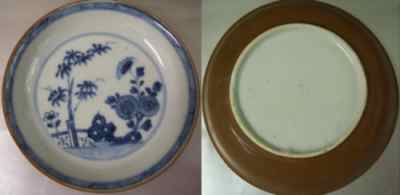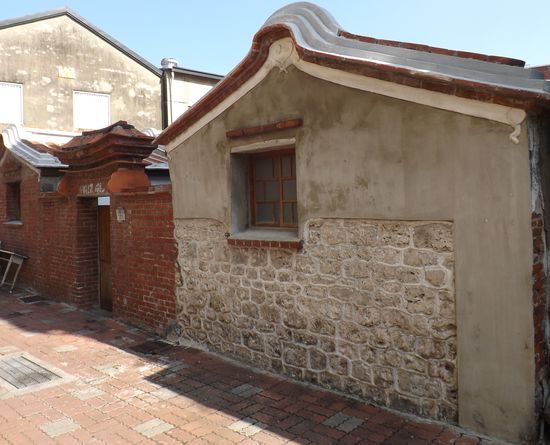Ancient China Trade & Porcelain Exports
The “ Silk Road ” was the earliest route for trade between ancient China and the West from a
very early time. Caravans carried their merchandise through central Asia to Europe more than two thousand years ago, and silk was already an
important export product in Roman times.
When the Europeans and their trading interests started arriving by ship in East Asia,
in the 16th century, the main trading routes changed to the sea. Ships allowed for faster transport of larger quantities. This China trade flourished for three
centuries.
 |
Batavia ware |
Although the majority of pottery and porcelain was shipped by sea, it is known that some ceramics were still transported by land
via the silk road.
Chinese ceramics were exported by sea as early as the 9th
century. In the Tang dynasty China already had indirect maritime trade
contacts with South Asia and the Middle East.
At that time much
of the wares were shipped first to Southeast Asian ports, and from there they
would be taken along the South Asian coast. These coastal trade routes
were used long before Zheng He with his fleet ventured into the Indian Ocean.
Non-Chinese shipwrecks with Chinese wares prove that the earliest trading westward was not done directly from China. The wares were shipped mostly to SE Asia from the Chinese coast, from where they were then shipped to South Asia and the Middle East.
During the Song dynasty the porcelain exported to the Middle East became
a commodity of high value throughout the region and was particularly
favored by the Ottoman Court.
As a result, today the ceramics collection of the Topkapi
palace museum
in Turkey is one of the largest collections of early Chinese porcelain in the world.
|
|
In the Song (960-1279) and subsequent Yuan (1206-1367) dynasties the majority of ceramics were produced for export. This may be one of the main causes that today relatively few of the blue and white porcelain items produced during the Yuan dynasty remain in China itself. This is especially the case with large-sized items. Smaller items like jarlets were often destined to SE Asian kingdoms of the time. It wasn't until the late Ming dynasty that the ceramics production for domestic use increased considerably. But, only in the Qing dynasty did it shift from mainly exporting to filling domestic demand. |
Pre-European maritime trade with SE Asia
One of the less known trading partners in the ancient China trade was
Tondo. This pre-colonial kingdom in the Philippines was a major link in China's foreign trade long before the arrival of the European
seafarers. Tondo was allowed to trade with China via the port of Fuzhou
since the early Ming dynasty.
Even during the Ming sea prohibition,
when all other trading contacts were broken off, Tondo was still allowed to continue trading with Ming China under the pretext of
"tribute".
Tondo was a major trading point and transshipment port for wares going to
Southeast Asia during the early China trade.
However, today it is known
that trade between China and the
Philippines was existing already at a much earlier time, namely in the 10th century, during
the Song dynasty.

European trade interests in the Far East and South East Asia
17th and 18th century ancient China trade
When the first European explorers arrived in the Far East, China had already been trading with other countries for a very long time. However, most of the trade goods were going only for short routes, either to Japan or SE Asia, which either were the goods destinations, or transshipment ports for faster journeys to South Asia or the Middle East.
The Portuguese:
The Portuguese were the first Europeans to reach China via the Cape of Good Hope. In the early 16th century they carried the first consignment of
china wares via the cape to Europe.
Around 20 years after their arrival, in 1535, they obtained permission from the imperial government to carry out trading activities from a base located in the area of Macao.
In the early 17th century the Portuguese shipped from Macao to
the port of Malacca, on the Malayan peninsula. The port of Malacca now
became a major transshipment port to Europe and the Near East, as well
as to other trading destinations in South East Asia. In 1641 the Dutch
captured Malacca from the Portuguese.
The Spanish:
The Spanish entered the China trade only after establishing a colony in
the Philippines. Later they traded mainly from their base in Manila with China
but at one time they had done so in the north of Taiwan to
protect their direct trade interests with China. Their sea trading route was leading over the
Pacific linking the Philippines and Mexico.
The Dutch:
When the Dutch arrived, they tried to be the most ambitious player in
the China trade. They established their center of operation in
Batavia (present-day Jakarta, Indonesia). From here they started
aggressively monopolizing all European and regional trade with China.
The
Dutch East India Company (V.O.C.) dominated China trade for almost two
centuries. The Dutch were also able to obtain a trade monopoly from the
shogunate in Edo (Japan), effectively becoming the only western people
allowed to trade with Japan during its seclusion. Regional trade with
Japan, Southeast Asia and South Asia became soon as important as the
trade with Europe itself as it was very profitable.
See VOC Trade Routes in Asia.
|
After driving the Portuguese from Malacca the Dutch started to dominate virtually all European trade in the region, actively hindering the trade of others, including
that of the Portuguese and the Spanish in Manila. |
|
The British East India Company:
In the 18th century the British presence in region grew stronger, their
main trading port was Guangzhou (old name: Canton).
The Swedish (SOIC) East India Company:
During the 80 years of its existence, the Swedish East India Company
based in Gothenburg made more than 120 highly successful voyages to
Guangzhou to import porcelain and other goods from the port of
Guangzhou.

Shipping Ports of the Ancient China Trade
Main port used for exporting in late Ming dynasty:
- Fuzhou: this was the port via which the kingdom of Tondo traded with China since the early Ming dynasty
- Yue port(月港) was the main port from where the porcelain from the kilns in the Zhangzhou area was shipped at the time. (See glossary)
In the Qing dynasty European traders used mainly:
- Portuguese: Macao
- Dutch: first Penghu (Pescadores islands), moved later to Anping in Taiwan, where they established the fort Zealandia. In 1662 it fell to the Chinese, after which most wares were shipped directly to the Dutch regional headquarters in Batavia (today's Jakarta). From there they were transshipped to other locations in South or Southeast Asia and Europe.
- British: Guangzhou (Canton), moved later to Hong Kong
- Spanish: established trading post in northern Taiwan which later was captured by the Dutch. From their headquarters in Manila the Spanish traded later with Portuguese Macao via their headquarters in Manila instead of buying directly from China.
- Swedish (SOIC): via Guangzhou (Canton)
The ancient China trade routes mostly followed one of two main shipping routes
through the South China Sea. The western route followed the coast of
Vietnam, whole the eastern route followed the island chain of the
Philippines and then along the Indonesian islands westward. Ships from both
routes would then pass through the Malacca straits west.
Only the Spanish sailed on an eastern route. After the Chinese
merchandise arrived in Manila from Macao, they would be shipped east
over the Pacific Ocean to the Mexican port of Acapulco. From there the
goods were transported over land to the Atlantic coast. There they where
then loaded on ships sailing across the Atlantic Ocean to Spain.
No matter whether sailing via Africa or Mexico, the European trading ships usually had to wait for the seasonal winds (trade winds) for months, or even half a year, until they could leave. Each trip would take more than one year. If the seasonal winds were missed, it could take two years or more for one trip to China and back.
More about ancient China Trade and shipwreck ceramics ...
Chinese porcelain - development influenced by economy and trends
Chinese Export Porcelain and Its Decorations
From Ancient China Trade to Porcelain Collections
Last updated: February 2025
